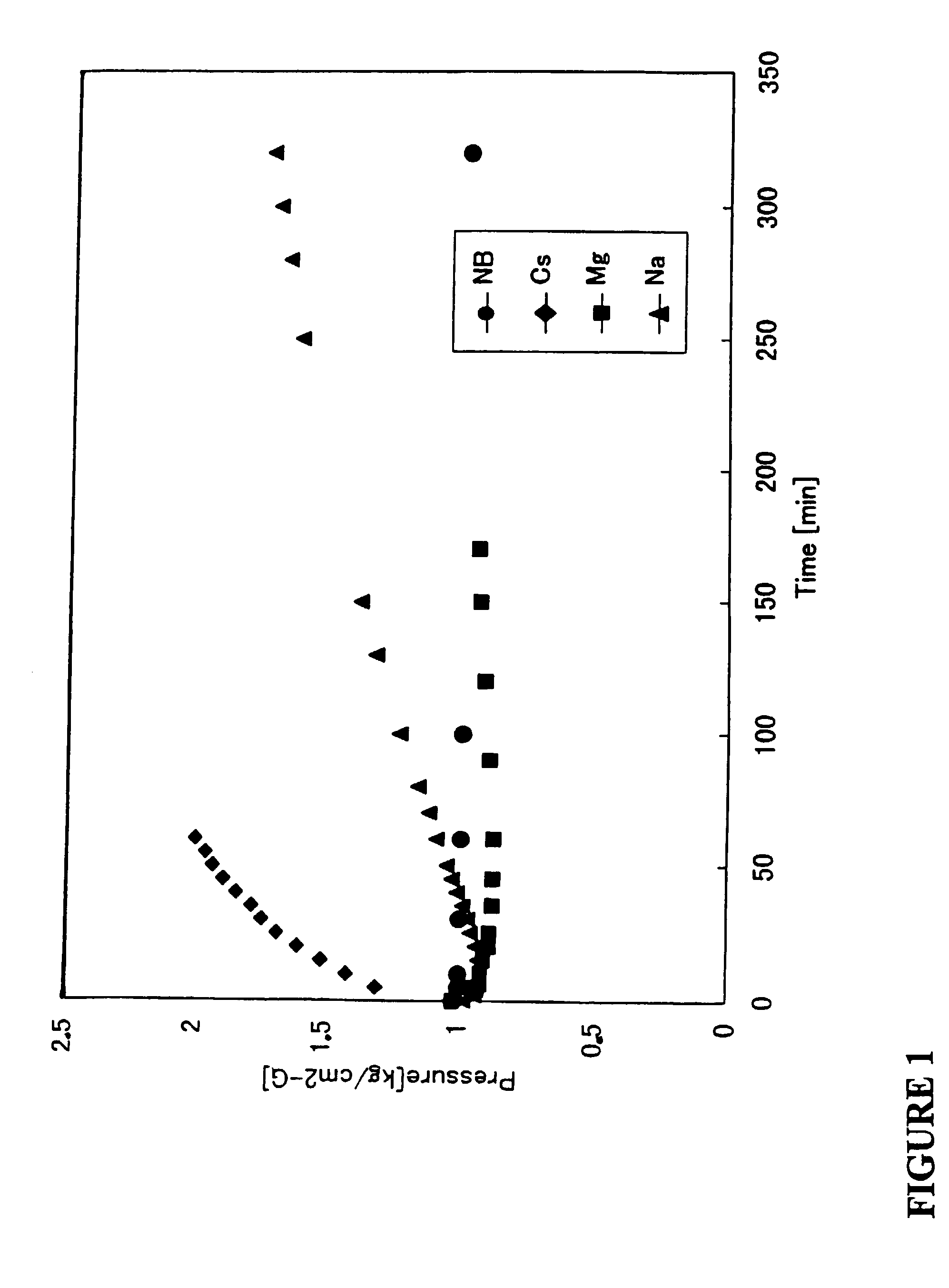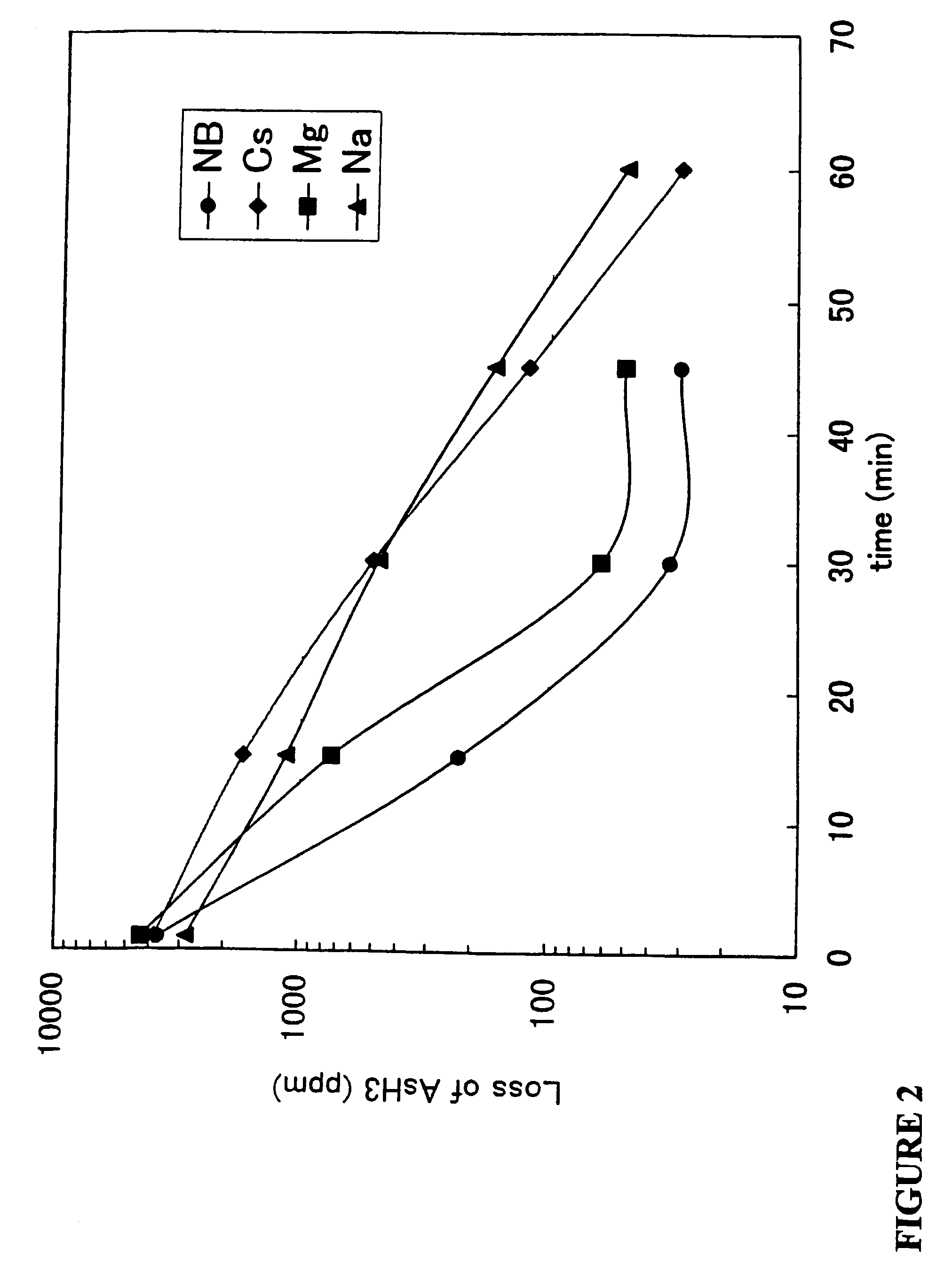Method and materials for purifying hydride gases, inert gases, and non-reactive gases
a technology of hydride gas and inert gas, applied in the field of gas purification and ultrapurification of bulk or matrix gases, can solve the problems of harmful foreign elements in these semiconductor materials, the level of traces of foreign elements in many processes is now regarded as too high, and the existing methods of purifying gases used in manufacturing microelectronic devices are generally insufficient to meet the need for ultra-pure gas, etc., to achieve selective and effective removal
- Summary
- Abstract
- Description
- Claims
- Application Information
AI Technical Summary
Benefits of technology
Problems solved by technology
Method used
Image
Examples
example 1
Preparation of Cs-modified Organic Alumina
[0060]Cesium carbonate (10.51 grams; 99% pure; Aldrich Chemical Company) was dissolved in 30 ml of deionized water. The resulting solution was added, drop by drop, during about a 30 minute time period, to 100 grams of organic alumina (PURALOX SCCa-(90–210), batch 1, obtained from CONDEA Vista Company) that had been freshly dried in a vacuum oven at about 105° C. for about 24 hours), using a 250 ml beaker, and in a manner known in the art as incipient wetness impregnation. This was followed by at least about 16 hours of equilibration at room temperature, after which the equilibrated material was transferred to a vacuum oven for drying at about 105° C. for about 20 hours.
example 2
Thermal Activation of Cs-alumina
[0061]Cs-modified alumina (60 ml) of Example 1 was loaded in a stainless steel tube, 2.54 cm in diameter and 30 cm in length. The tube was equipped with an entrance valve on top and an exit valve at the bottom, separated physically from the purifier material by means of a particle filter. Purified nitrogen gas (purified over Nanochem® OMX) was passed through the filled tube for 15 hours at a flow rate of 1 standard liter per minute (slpm). Then, with the aid of a heat tape, the temperature of the tube was increased to 320° C. and maintained at this point for 24 hours. The material was then cooled to room temperature under the same flow of dry nitrogen, followed by an additional 15-hour period of nitrogen flow through the purifier.
example 3
Preparation and Thermal Activation of Mg-modified Organic Alumina
[0062]Modification of organic alumina (PURALOX SCCa-(90-210), batch 1, obtained from CONDEA Vista Company) with magnesium (Mg) was performed as above described in Example 1. Magnesium acetate (13.4 grams; Mg(OAc)2:4H2O); 99% pure; Aldrich Chemical Company) was dissolved in about 30 ml of deionized water. The resulting solution was then added to 100 grams of CONDEA organic alumina, followed by equilibration at room temperature and vacuum oven drying. Thermal activation of the Mg-modified organic alumina was then performed as in above Example 2.
PUM
| Property | Measurement | Unit |
|---|---|---|
| temperature | aaaaa | aaaaa |
| temperature | aaaaa | aaaaa |
| temperature | aaaaa | aaaaa |
Abstract
Description
Claims
Application Information
 Login to View More
Login to View More - R&D
- Intellectual Property
- Life Sciences
- Materials
- Tech Scout
- Unparalleled Data Quality
- Higher Quality Content
- 60% Fewer Hallucinations
Browse by: Latest US Patents, China's latest patents, Technical Efficacy Thesaurus, Application Domain, Technology Topic, Popular Technical Reports.
© 2025 PatSnap. All rights reserved.Legal|Privacy policy|Modern Slavery Act Transparency Statement|Sitemap|About US| Contact US: help@patsnap.com


